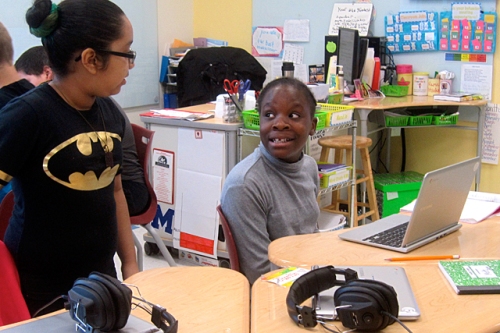Larry Cuban on School Reform and Classroom Practice: Technology Use in Special Education Classrooms (Gail Robinson) (by Gail Robinson)
Journalist Gail Robinson wrote this piece for the Hechinger Report on June 5, 2014
Eleven-year-old Matthew Votto sits at an iPad, his teacher at his elbow. She holds up a small laminated picture of a $20 bill.
“What money is this?” she asks. Matthew looks at the iPad, touches a square marked “Money Identification” and then presses $20. “20,” the tablet intones, while the teacher, Edwina Rogers, puts another sticker on a pad, bringing Matthew closer to a reward.
They race through more questions. “What day of the week is it?” “What is the weather outside?” “What money is this?” In most cases, Matthew, who has autism, answers verbally, but he is quicker and seems more comfortable on the device.
A few classrooms away at Eden II, a Staten Island, N.Y., nonprofit that provides programs for people with autism, the going is slower but the approach is the same. Anthony Scandaglia, a teenager who does not really speak, tries to identify simple activities on the iPad. “What do you use to drink?” the teacher asks. He presses a picture of a cup.
“Where do you wash dishes?” asks the teacher, Colleen Kenny. Anthony selects the picture of bed. “No, we wash dishes in a sink,” she says.
Anthony and Matthew are among a growing number of children on the autism spectrum who use electronic devices — in their cases iPads equipped with a software program called Proloquo – for learning. Just a few years ago, they would have used bulky communication devices costing $6,000 to $10,000, if they used any technology at all. Or, they would have communicated by picking out pictures and sticking them to a board. “We spent a lot of time laminating and Velcroing,” recalls Melissa Cantwell, who teaches autistic children in Vancouver, Wash.
Special education students have long used so-called assistive technologies, like audio books for the visually impaired or special transmitters for hearing-impaired students. So today’s trend toward blended learning – the combining of technological devices with more traditional instruction – may seem less jarring to these students than to their general education peers.
“We have so many different programs that will help a child,” says Valeska Gioia, an assistive technology specialist at the South Carolina Department of Education, who focuses on struggling students and students with moderate to profound disabilities of many kinds, including autism. “We give them the tools and they rise to the challenge much of the time.”
Many teachers, parents and administrators say that laptops, tablets and the various apps help engage and motivate special ed students, while also making it easier for teachers to individualize instruction and track progress. Others caution that, as with so much in the world of educational technology, definitive research about results is scant.
“There is little research on how students with disabilities are doing with on-line and blended learning,” says Tracy Gray, managing researcher for education at the American Institutes for Research, a nonprofit that conducts behavioral and social science research. “For whom does this work, under what circumstances and with what support? We can’t answer that for general education, let alone special education.”
But some specialists believe that children with certain kinds of disabilities, such as those on the autism spectrum, respond especially well to technology programs because the programs behave in consistent, predictable ways. And unlike earlier technologies for students with special needs, the tablets and laptops are portable and indistinguishable from devices used by other students.
As developers continue to design a huge array of products – from free apps, such as Bookshare, to expensive robots – hopes are running high. Some programs help students with attention deficit disorders get organized; others track students’ individual education plans, or provide lists of words to prompt struggling writers.
At P. S. 176 in Brooklyn, N.Y., a dozen third graders sit in a classroom. A large interactive white board displays a snake skin, a turtle shell and a honeycomb, all examples of repeating patterns known as tessellation and all housed at theLiberty Science Center in Jersey City, N.J.
A friendly male voice from the screen directs the children to draw a triangle with sides of 6 inches. For some, it is laborious, but he urges them on. “Hopefully I’m not running into lunch period,” the voice says. “I’ll give you two more minutes.”
The lecture is coming to the children live from the science center. Meanwhile, as in a chat room, the teachers at P. S. 176 type in their observations about how the lesson is going, allowing the Liberty instructor to adapt to the students’ pace and mood.
All students at P. S. 176, where more than 10 percent have special needs, participate in the partnership with Liberty, but third grade special education teacher Christina Panichi feels it has particular value for her students. “It’s like going on a trip with hands-on materials,” she says. “The only down side is they can’t touch it.”
Panichi also thinks having the material online helps. “It’s more like a game for them,” she says. “For some reason when technology is involved — especially cartoons — it engages them more.”
In Middletown, N.Y., a virtual number machine on her tablet is absorbing the attention of a little girl in a fourth grade special education classroom at Presidential Park Elementary.
As soft music plays in the background, she selects a number to insert into the “machine” on the screen of her Samsung Chromebook. The screen machine belches out a different number at the other end. After a few rounds, it asks the pupil what the math machine is doing to the number she inserted. In this case it’s adding seven.
This is Jessica Indelicato’s class, one that is the very model of a blended classroom. Several other students are bent over computers, all equipped with various education programs and Google docs, doing different tasks that vary with their progress and abilities. Meanwhile, Indelicato discusses decimals with five students, and a third group sits on the rug combining blocks to create numbers with decimals. In a few minutes, all students will rotate to the next station.
Indelicato sees the technology as key to engaging her students, in math and in reading. “It’s amazing. It targets whatever special skills they need help with,” she s. “They’re motivated. They enjoy it.” Their work on the computers, she says, “gives them reinforcement and confidence” that they carry into discussions about math.
Indelicato, Panichi and other teachers observe that many students simply find a lesson more attractive when technology is involved. Many programs features cartoon figures, instant responses, bright colors, music and encouraging voices. Those things draw students in.
Nowhere has the interest in technology been greater than for students on the autism spectrum. Debra Jennings’s son, Brady Bartsch, 9, who has Asperger’s, exhibited learning difficulties in kindergarten, and it seemed clear he was not going to learn to read by sitting down with conventional books. He began working on a Galaxy tablet equipped with Raz-Kids, an interactive program that incorporates a reward system. His mother says he’s made enormous gains. Brady, now in second grade at a Staten Island public school, “almost goes out of his way to be the star,” she says. “He’s shifted from being in the back of the room to wanting to be an example.”
Andy Shih, the vice president for scientific affairs at Autism Speaks, a research and advocacy organization, has seen similar examples.
“A lot of families are telling us how technology, particularly apps and iPads, are contributing to a quality of life for their kids they couldn’t begin to imagine,” he says. This is particularly true for those who cannot speak, which, Shih says, “doesn’t mean that they’re incapable of communication with others or that they don’t have a rich inner life.”
Shih says technology may help autistic students because it is simpler to “read” than people. “What technology does is simplify interaction,” he says. “Interaction with an app is always going to be the same. The expectation is always going to be consistent. Interaction with individuals is far more complex.”
As with general education students, technology is more successful for some children with special needs than for others. Even among autistic students, where it seems to hold the greatest promise, technology is not always successful. Some have no interest in their electronic devices, while for others, they become a kind of obsession.
Providing tablets and laptops to students with disabilities raises many of the same concerns that giving them to general education students does. Cost is clearly one.
Ms. Gioia, the South Carolina technology specialist, is always on the lookout for free tools and says most districts in her state have stayed away from Macs because of their higher cost. Some schools rely on fund-raising to cover some of the costs. While not denying that the devices can be pricy, Karen Cator, director of Digital Promise, a nonprofit focused on innovation in education, advises schools to look at whether they can be offset by some savings; maybe a student with a tablet is less likely to need a full-time, one-on-one aide.
Some experts think one of the greatest pitfalls of technology is that people will expect it to do too much, that they will see what’s new and glittery — what Andrew Hess, the assistive technology specialist for the Mamaroneck, N.Y., schools, calls the “mynah bird syndrome” — and ignore its limitations.
Aaron Lanou, director of professional development at the ASD Nest Support Project at NYU’s Steinhardt school, proposes two questions about technology: “Is this tool going to make something easier and more engaging, or is it just novel?” he says. “And, we need to ask teachers to think about the amount of time kids are actively engaging and using the tool versus the time it takes to learn the tool.”
Gray, of the A.I.R., emphasizes that no technology, no matter how dazzling, can do it alone. “There’s no magic here, whether you’re talking about kids with disabilities or general education classes,” she says. “You need teachers who understand technology, the support to do it well, and professional development.”
This blog post has been shared by permission from the author.
Readers wishing to comment on the content are encouraged to do so via the link to the original post.
Find the original post here:
The views expressed by the blogger are not necessarily those of NEPC.



